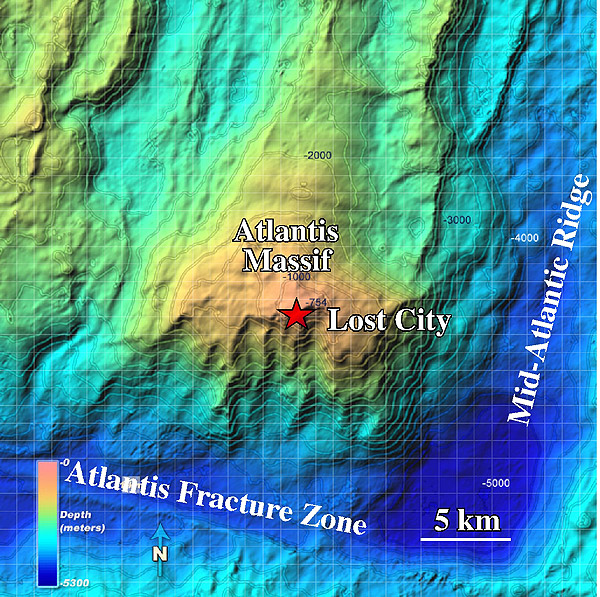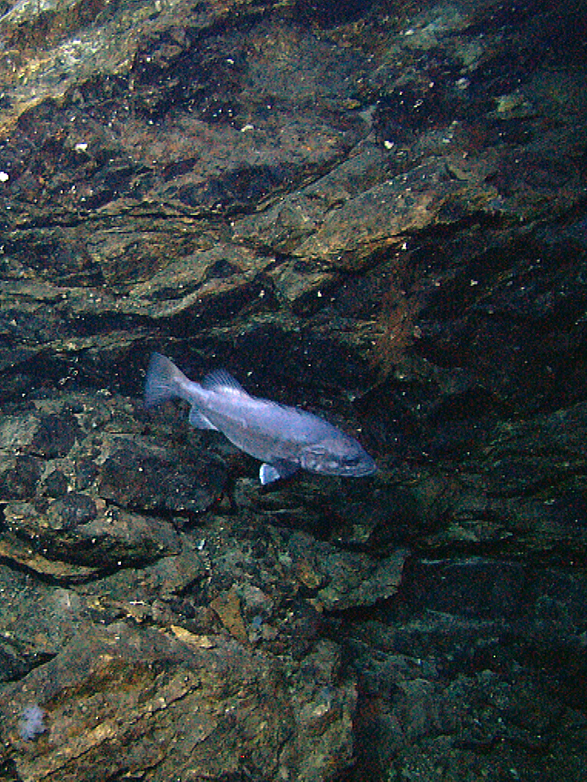Traces of life discovered in mantle rock
An international expedition, led by ETH Professor Gretchen Bernasconi-Green, has discovered traces of life in a core sample. The geologist explains what this means.
An international team of scientists returned last December from an external page IODP (International Ocean Discovery Program) expedition to the Atlantis Massif in the Atlantic Ocean. During the expedition, they were able to obtain a series of mantle rocks in core samples taken from the seabed near the famous Lost City hydrothermal field. When they analysed the rock samples, the researchers discovered signs of life. The expedition’s co-leader, ETH Professor Gretchen Bernasconi-Green, spoke to ETH News about whether and why the find can be considered a scientific sensation.
Ms Bernasconi-Green, an expedition you led to the Atlantis Massif on the Mid-Atlantic Ridge has discovered traces of life in mantle rock. That sounds like a scientific sensation – is it?
First, I should say that we did not find the signs of life in the earth’s mantle itself, but rather in rock that originates from the earth’s mantle. This rock is found on the seabed at the Atlantis Massif near Lost City. Here the tectonic plates are drifting apart and large active faults have formed that carry mantle material towards the surface, just like a conveyor belt. We were able to obtain samples of the mantle rock through boreholes, and a microbiologist on the research ship managed to isolate cells from a few of these samples.
What kinds of cells?
For now, all we know for sure is that they are microbial cells. Whether these are bacteria or archaea, it’s too soon to say. What we do know is that they differ considerably from cells found in ocean sediment. The next step is for the cells to be examined more closely in the laboratory. What’s unusual, and quite exciting for us, is that these cells are present in mantle rock and most likely do not originate from the seawater.
Do you think it’s really possible for life to occur in rock?
Yes, I think it is quite possible. Mantle rock contains a mineral called olivine, which turns into serpentine when it comes into contact with water at low temperatures. This produces hydrogen and methane. Both these gases provide a source of energy for micro-organisms that have to manage without sunlight. Perhaps the cells we found are capable of using these gases, which are present inside the rock, to carry out their metabolic processes. But life in the rock is tough and the microbes are exposed to some very hostile conditions. The fluids that seep out of the vents at Lost City are extremely alkaline – they have a pH value of 11. Thus, both the vents and their environment are difficult to colonise, even for very resistant micro-organisms.
What is the significance of finding cells in rock like this?
The conversion of olivine to serpentine may occur on other planets too – on Mars, for example, where the presence of methane and hydrogen has already been established. Some scientists believe that would be sufficient in itself to allow the emergence of basic life forms.
What other goals did you set for the expedition?
Mainly, we wanted to find out how mantle rock ended up on the sea floor and how it reacts with seawater; the primary focus was on the serpentinisation process. We also wanted to find out more about the carbonisation process that led to the formation of the vents at Lost City. The chimneys are made of calcium, or rather calcium carbonate, which precipitates from the alkaline fluids. This is a natural form of carbon dioxide fixation. We wanted to better understand how much carbon is stored as carbonate in these rocks and the potential of this sequestration, especially in terms of an artificial CO2 sequestration on the sea floor or on land, aided by the serpentinisation reaction that led to the formation of alkaline hydrothermal vents.
Have you come to any conclusions about this potential yet?
We have not finished analysing the core samples yet, but I see the potential as being quite limited. It may be feasible, but the effort required to fix significant quantities of CO2 in places like the mid-ocean ridges would be very great – too great for it to be successful.
What other findings resulted from the expedition?
This expedition was the first time that we used a new kind of drill, a seabed rock drill, to extract core samples. These drills sit right on the seabed and can drill 50 to 70 metres into the rock. The advantage over the conventional method is that the drill is not as disturbed by heavy seas. The drill heads are finer, too, which is less damaging to the rock. As the boreholes are often left open for long periods, thus letting in seawater, we used a new technique to seal up four of the boreholes. This is another example of innovation in sea drilling. In a year’s time, the area in and around the boreholes will have recovered from the disturbance of drilling and we will be able to remove the plug and take measurements and water samples. We also equipped the drills with a number of different sensors, which, for the first time, were able to measure the water temperature, oxygen reduction potential, methane concentration and the pH of the water before, during and after the drilling process.
So what happens next?
The core samples were taken to the Center for Marine Environmental Sciences (MARUM) in Bremen, and over the last two weeks have been examined by the team of 30 participating scientists. Incidentally, women are in the majority on that team – another first on an IODP mission! They will each take small samples and continue their analysis. The microbiologists will also conduct detailed genetic investigations and make incubation experiments. In about two years, we will reconvene to discuss the results.
Will you take part in the analysis?
Yes, I’ll bring samples back to ETH Zurich and, together with my colleagues, analyse them for carbonates, organic carbons and mineral reactions related to serpentinisation.
The project, incidentally, is financed by the Swiss National Science Foundation, which also ensures Swiss membership in IODP.
Lost City

In 2000, researchers on an expedition for the US National Science Foundation discovered a field of hydrothermal vents on the Atlantis Massif, featuring a series of extraordinary limestone chimneys, which reach heights of up to 60 metres. The researchers named it after the mythical lost city of Atlantis. The area lies on the side of a 3,800-metre-high underwater mountain range and is part of the 20,000 km Mid-Atlantic Ridge. external page Lost City is markedly different to other hydrothermal areas, such as the Black Smoker chimneys. The chimneys at Lost City emit mainly methane and hydrogen into the surrounding water. These gases originate from highly alkaline, concentrated solutions with a pH value of between 9 and 11, and temperatures ranging between 40°C and 90°C. These fluids form when water reacts with rock originating from the earth’s mantle and turns it into serpentine. Methane (CH4) and hydrogen gas (H2) are created in the process. Mantle rock is carried from several kilometres deep to the sea floor by tectonic processes. The released gases can then be used by micro-organisms.




Comments
No comments yet